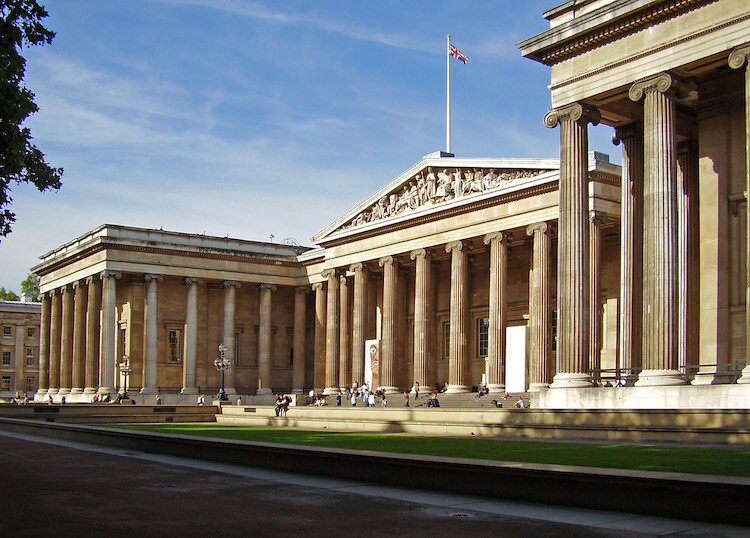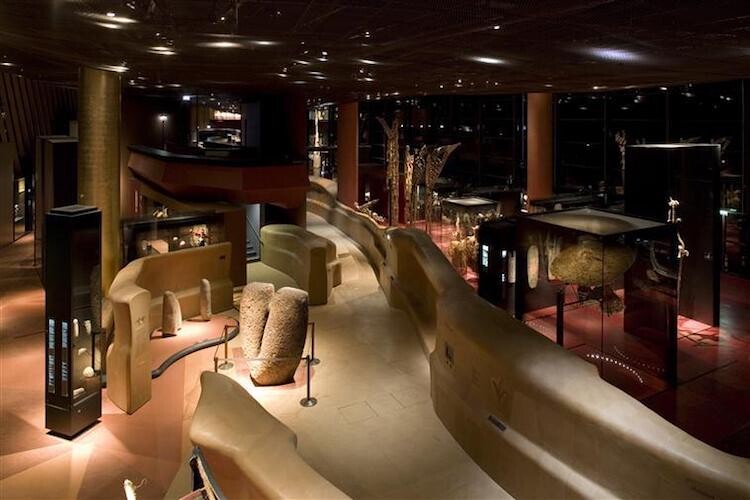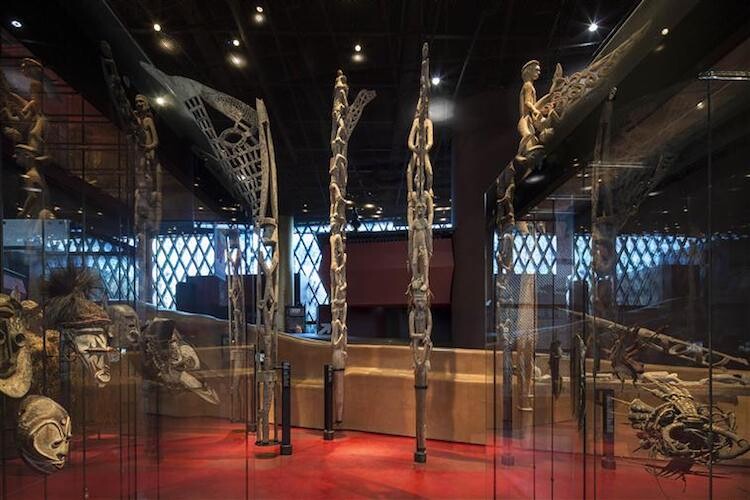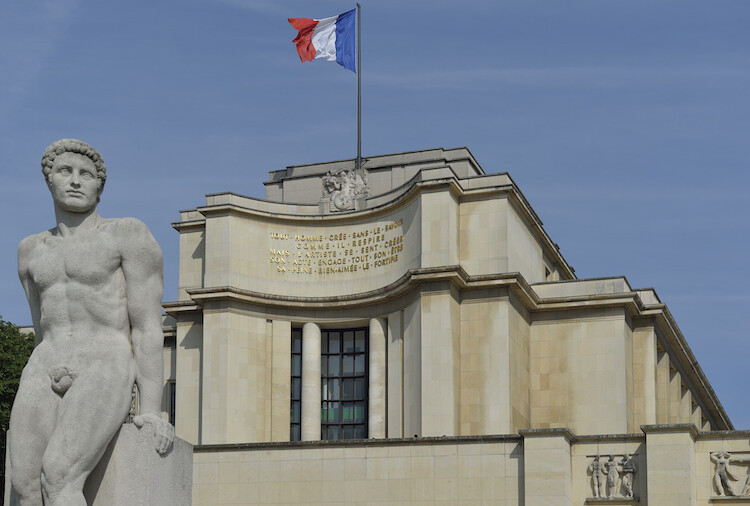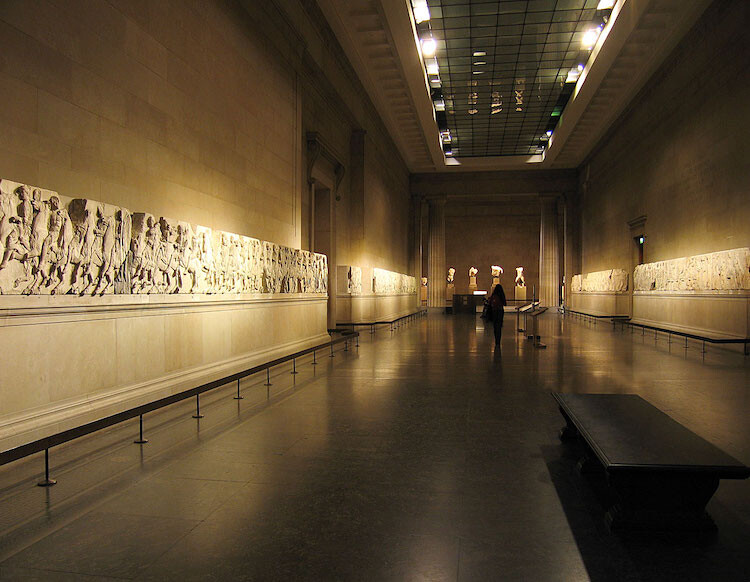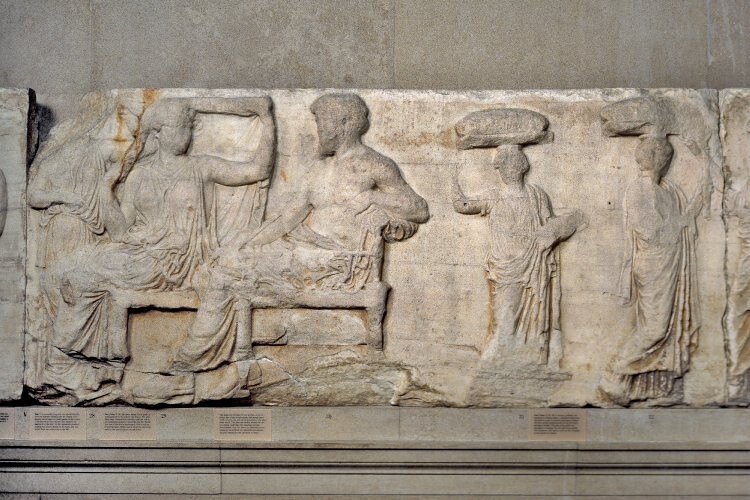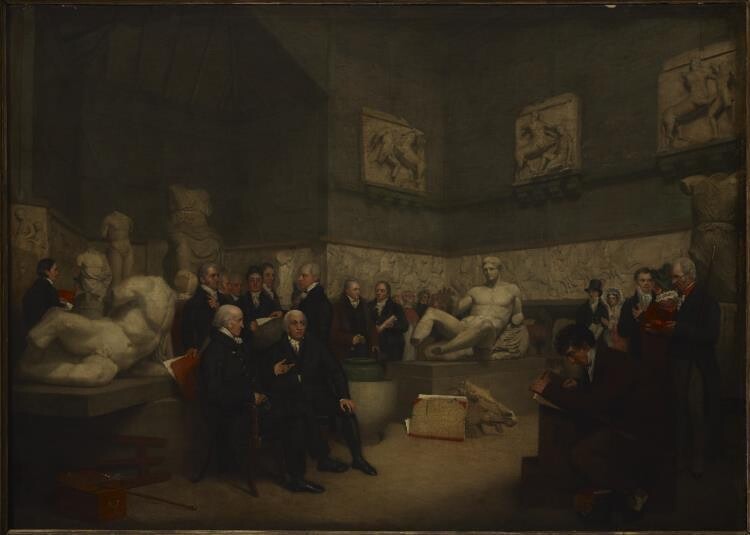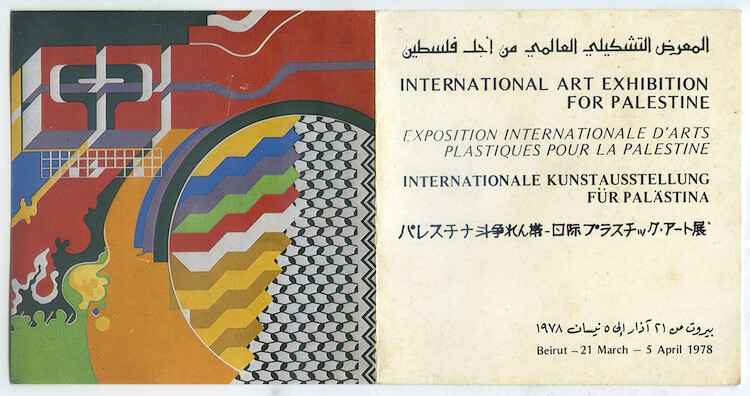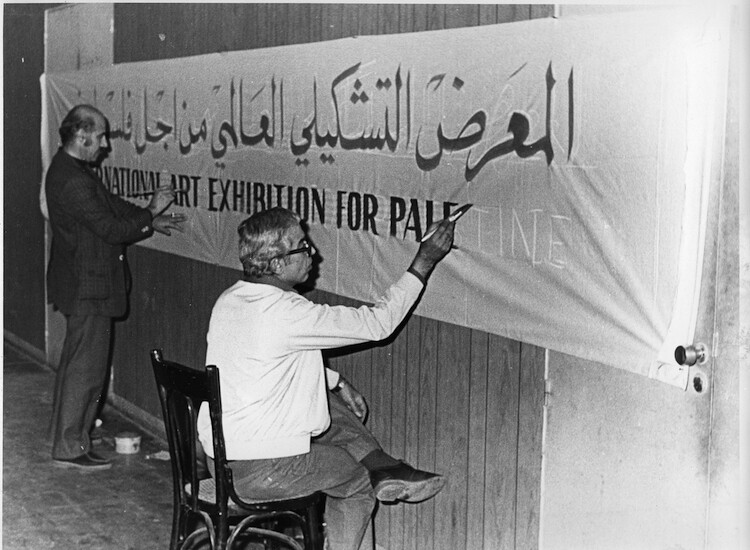The main floor of the Musée du quai Branly, inaugurated in 2006, is structured with thick, earth-toned walls. Like the walls of homes one would imagine in villages where an ambient heat requires two feet of earth to maintain the cool of the interior. I run my fingers along one wall lightly, reveling in its softness, before turning to really look at the surface that extends everywhere, like an organizing logic. It is leather. Real leather, aged by the passage of myriad fingertips over it, embossed at strategic intersections of the exhibition plan with maps and other contextual information. The galleries are lined with skin dyed in a lustrous and uniform shade of golden brown. The symbolism of spatially delineating an exhibition space that is exclusively devoted to the arts and material cultures of indigenous and “non-European” civilizations with animal skin reads immediately as a metaphor for the psychological and economic structures of colonialism.
The use of leathered skin throughout the permanent galleries of the quai Branly reminds the viewer that what is really at stake in glorifying the material cultures of the colonized is the exposition of a colonial prerogative to treat living beings as things to be captured and skinned. Its use also denotes the “primitivism” that justified the French mission civilisatrice, or the moral obligation to help those who were incapable of becoming “civilized” without outside intervention. Colonialism treats land, animals, and people as things to penetrate and to relieve of their chaotic interiorities. The use of skin signals an understanding of the Other that permits this extraction, namely a primitivist one.
Walking through the galleries of the Musée de l’Homme, also in Paris, my student Jorge stopped to take a photograph out the window of the sun beginning to set over the Eiffel Tower across the river.1 He caught me watching him observe Paris’s most iconic monument, built with Algerian steel at the end of the nineteenth century, and turned back to the exhibit with a hurried gesture, as though he had been distracted from the task at hand. He was, in fact, attending to the task set by architecture, which was to marvel at the view of the city afforded by the building after having marveled at the things of the world amassed and categorized in said building. The Musée de l’Homme, especially in its golden age, was a mechanism connecting that picturesque, aerial view of the modern city with a panoptic view of Others and their objects. The museum was a bridge between realms that reified their difference: Paris as the modern experience and Africa as the pre-modern experience. Not only was the museum confirming Paris’s modernity, it was also containing the pre-modern, in every sense of that word, so that those with access could experience the pre-modern without losing their own position in modernity. To be a modern subject, thus, was to be able to imagine that one could experience all positions in time and space without leaving the city, with its consumer comfort, safety from conflict, and the space/time compression of a modern—controlled, aseptic—environment.
The Musée du quai Branly, with all the controversy it provoked in French cultural circles as a postcolonial musée manqué—a French turn of phrase used to describe tomboys, garcons manqués—is certainly lacking in self-reflexivity2 and its failure is partially due to France’s particularly myopic relationship to its postcolonial responsibilities.3 Further, the Musée de l’Homme was abandoned by its collection, it is today an obsolete space, and whatever distinction it once policed between human civilizations by way of juxtaposition is also obsolete. It is tempting to assign these institutions’ structural violence to the past, as the unfortunate evolution of the colonial expositions and world’s fairs of the nineteenth century or, in the case of the Musée du Quai Branly, to the persistence of outdated notions of cultural difference.
Yet the design choices of nineteenth and twentieth century exhibition spaces in Paris render visible a fundamental relationship between the display of aesthetic objects that belong to “unassimilable” registers of political subjectivity and the colonial foundation of liberal nationalism. In an essay published in 1988, sociologist Tony Bennett argues that the exhibition emerged at a moment when state power was receding from public view in its most violent forms, leading the state to desperately search for rhetorical devices with which to exercise power. Bennett writes: “Museums may have enclosed objects within walls, but the nineteenth century saw their doors opened to the general public—witnesses whose presence was just as essential to a display of power as had been that of the people before the spectacle of punishment in the eighteenth century.”4
Bennett suggests that the public display of objects from Africa, Oceania, the Caribbean, and the Maghreb served an analogous purpose to that of gruesome public torture and execution in the previous century. The viciousness of state power may have been visually displaced to the margins of empire, but it still needed mechanisms with which to remind its subjects of the reach of that power. The function of exhibition spaces was thus to produce public identification with state power, to implicate viewers in an encyclopedic project whereby the world beyond France and Europe could be known and—through knowledge—controlled.5 The grandiose international and colonial exhibitions of the nineteenth century eventually gave way to so-called universal museums—the Metropolitan Museum in New York, the Germanisches Nationalmuseum in Nuremberg, Germany—which were quickly founded as the permanent surrogates of previously temporary spaces.
Bennett doesn’t suggest that only those spaces that perpetrated direct forms of symbolic violence participated in the spectacle of state power in the nineteenth century—those that, for example, showed the genitalia of African women (the Musée de l’Homme) or that refused to return the Elgin Marbles to Greece because of some misguided prerogative of universal historical guardianship (the British Museum). Bennett’s analysis is far more structural and useful beyond the historical period he describes. In his view, the project of decontextualizing aesthetic objects is bound up in liberal nationalism: both are founded upon the confrontation with those objects and the people who made them, who are destroyed in the process of being assimilated to liberal state power.
Does Bennett’s analysis extend far enough to describe the art gallery in its current blank form? The white cube, by virtue of its whiteness, is thought to be free of the most egregiously problematic metaphorical associations, and it is true that its display choices do not impose epistemological positions with the exacting force of leather walls.6 Yet the gallery is conceived as an empty space, purposefully purposeless, its whiteness contextualized as hygienic neutrality. As such it is indeed an extension of the political mechanism Bennett describes: the gallery’s function is to produce an identification with whiteness, which is a form of subjective abstraction that depends on the availability of un-abstractable subjects.
What is an un-abstractable subject? Whiteness is an ideological structure interdependent with blackness, with the former free to signal the universal because the latter is abject; white bodies are free because anything can be done to black bodies.7 In this system of representation, whiteness is a racialized social category to signify the privileged universal subject, who possesses the freedom to be abstract or to speak for “humanity,” because whiteness is the unmarked position in contemporary political discourse from which all social reality is, in fantasy, visible. Within this binary structure, the same privilege is not accorded to blackness; bodies marked by it cannot be abstracted.8
The presumed neutrality of the exhibition space promises to make all experiences equally available to viewers. The exhibition space was designed as the colonial space par excellence insofar as it allowed objects to be re-contextualized to produce the identification of viewers with hegemonic power and it continues to produce the fantasy of the experience of decontextualized things.
Despite being saturated with epistemological violence, such spaces shouldn’t be unilaterally abandoned. Curator Rasha Salti begins a text on “Past Disquiet,” an exhibition she co-curated with Kristine Khouri around the “International Art Exhibition for Palestine, 1978” with a quote from philosopher Achille Mbembe that it is worth revisiting: “I’d say memory is, above all else, a question of responsibility with respect to something of which one is not the author. Moreover, I believe that one only truly becomes a human being to the degree that one is capable of answering to what one is not the direct author of, and to the person with whom one has, seemingly, nothing in common.”9 The “International Art Exhibition for Palestine, 1978,” was the result of the Palestinian Liberation Organization (PLO) soliciting donations from 200 artists from all over the world to constitute a show that opened in Beirut in 1978 and was meant to travel as a cultural emissary of the Palestinian struggle. Salti calls on Mbembe to frame an impossibility—that of trying to unearth the memory of a moment of collective solidarity without immediately abstracting it from its complex historical context, or feeding it into a market ravenous for “political art” from the Arab world.
The example of Salti and Khouri’s research suggests that the way forward may be to accept the responsibility for those aspects of the exhibition space that bypass one’s deliberations, namely its abstraction of bodies and space upon which colonialism depends. Such responsibility would require that each exhibitionary gesture acknowledges the context out of which it derives meaning, and the unequivocal acknowledgement that the exhibition space leaves open the possibility of neocolonial violence.
The encyclopedic and universalist history project of the nineteenth-century exhibitions and the absence (or inverse) of a historical project in the white cube is central to the subjective identification required by hegemonic power—whether state or neo-liberal state power—at each temporal juncture. Of course, the ideological ground beneath the Musée du quai Branly and the Musée de l’Homme has shifted, but because they cannot address the impossibility at the heart of their respective universalizing projects, the violence that authorizes these projects is thrown into higher and higher relief as time moves around them. They are spaces stuck in time, bound in leather.
Jorge Torrens was a student at the Cultural Pluralism I taught in the Spring of 2017 and 2018 as part of the MA in curatorial practice program at Parsons School of Design in Paris. Many of the insights described here come from our class discussions about the spatial legacy of colonialism in the Parisian context. I wish to fully acknowledge their intellectual contribution: Tala Alghamdi, Basma AlShathry, Serra Cenkçiler, Maria Del Pilar Gimenez Burlo, Wanyun Gu, Sharae Hamilton, Chanel Host, Wei Chu Hsu, Erica Kermani, Sif Lindblad, Gabrielle Lisk, Malique Moore, Forrest Pelsue, Abbygail May Talao, Mellany Tellen, Jorge Torrens, and Brian Tsao.
Curator Clémentine Deliss’s analysis of the Musée du quai Branly in the context of her work on decolonizing the museum makes a different, though related, criticism of the museum’s exhibition spaces. Her project posits the possibility of reform, whereas I argue neither for reform nor for a complete dismantling, but rather for the acknowledgement of the epistemological violence inherent to these institutions. The practical consequences of such an acknowledgement are as of yet unimaginable. Clémentine Deliss, “Collecting Life’s Unknowns,” in Decolonising Museums, see: http://www.internationaleonline.org/bookshelves/decolonising_museums.
I am not suggesting that other former colonial powers fully accept their post-colonial responsibilities but that France does a particularly poor job of it, as Benjamin Stora argues with regard to the Algerian context in La gangrène et l’oublie (Paris: Ed. de la Découverte, 1991). I base my judgment on the lack within the French context of an intellectual project to rival those of Stuart Hall, Homi Bhabha, Gayatri Spivak, Kobena Mercer, or Edward Said. While Frantz Fanon wrote in French and about the French colonial situation, he is neglected within French academic studies and is more widely read in English language. Achille Mbembe, a Cameroonian postcolonial scholar with PhD from La Sorbonne, has worked outside of France since the year before he awarded his doctorate.
Brian O’Doherty, Inside the White Cube: The Ideology of the Gallery Space (Los Angeles: University of California Press, 1999).
Tony Bennett, “The Exhibitionary Complex,” New Formations (No. 4, Spring 1988): 73.
Following Bennett in this text, I remain in the nineteenth century, but it is worth pointing out that during the modern museum’s invention in the eighteenth century, it already functioned in a similar capacity: as a site in which publics were sutured into identification with state power. See, for example, Andrew McClellan’s excellent study of the Louvre: Inventing the Louvre: Art, Politics and the Origins of the Modern Museum in Eighteenth-Century Paris (Berkeley: University of California Press, 1999).
This position is succinctly articulated in an interview between Saidiya V. Hartman and Frank B. Wilderness: “The Position of the Unthought,” Qui Parle, 13.2 (2003): 183–201. Available online: https://sites.tufts.edu/english173/files/2017/01/Saidiya-Hartman-Interview-with-Frank-Wilderson-The-Position-of-the-Unthought.pdf. Integrating the perspectives of people of color into the current gallery infrastructures is urgent and necessary. As Hartman and Wilderson argue together, and in each of their respective intellectual projects, integration does not guarantee a challenge to hegemonic whiteness. That would require dismantling the violent binary conception that exhibition spaces were historically invented to help police.
Text originally written for “Past Disquiet,” an exhibition held at MACBA, Barcelona, in 2015. This point is one of Frantz Fanon’s fundamental insights in Black Skin, White Masks (New York: Grove Press, 2008), drawing together European and North American discourses on blackness, which is also one intention of this text.
“What is Postcolonial Thinking?” Achille Mbembe interviewed by Olivier Mongin quoted in Rasha Salti, “Around the Postcolony and the Museum,” in Decolonising Museums (L’Internationale Online, 2015), http://www.internationaleonline.org/bookshelves/decolonising_museums.
